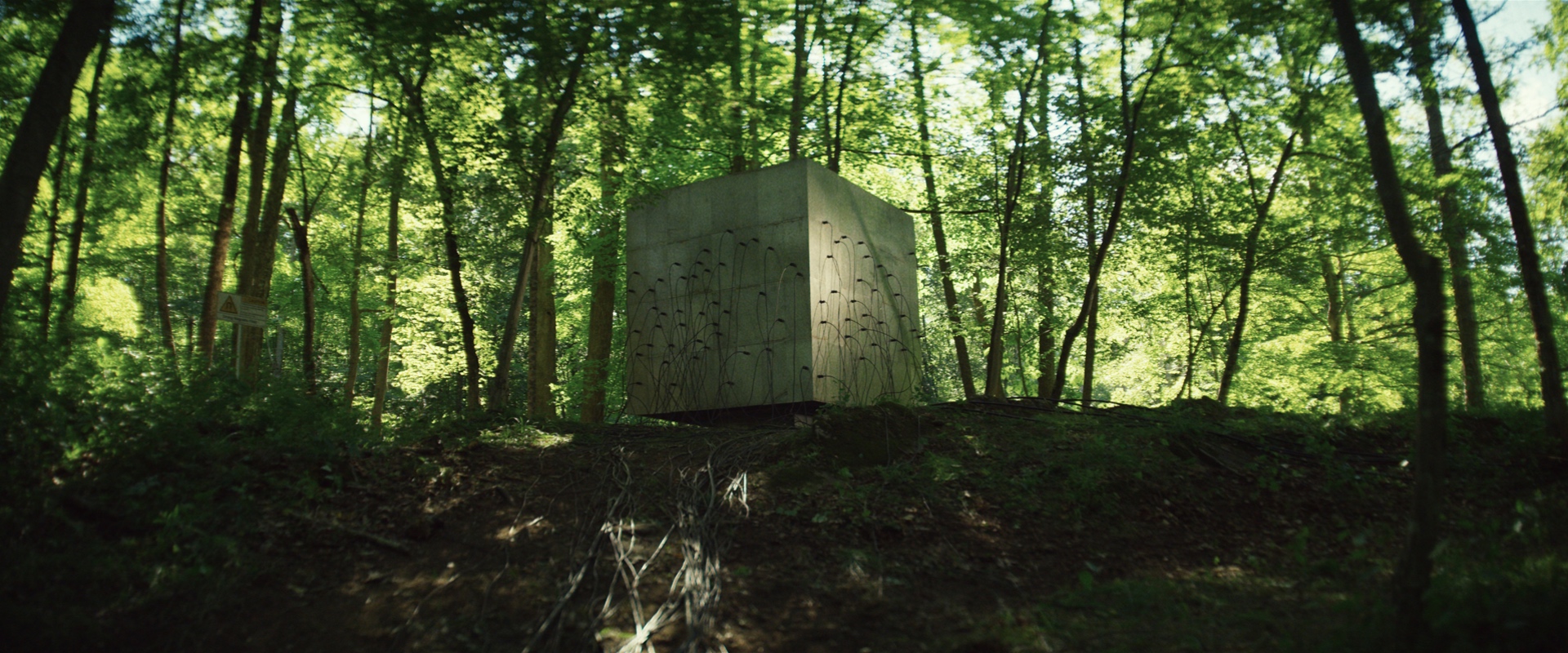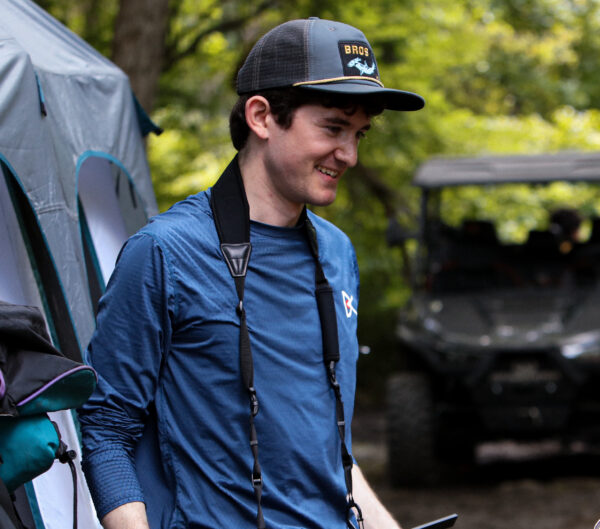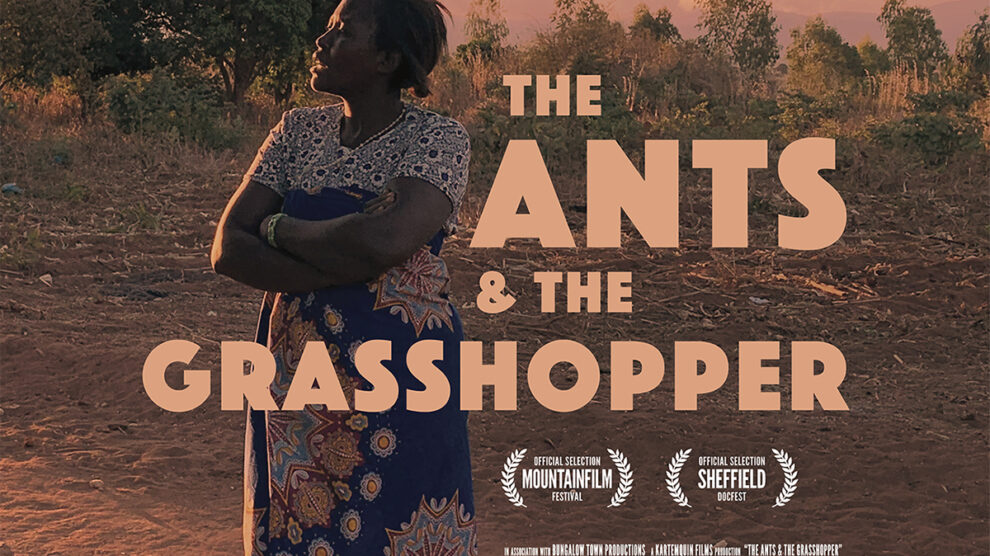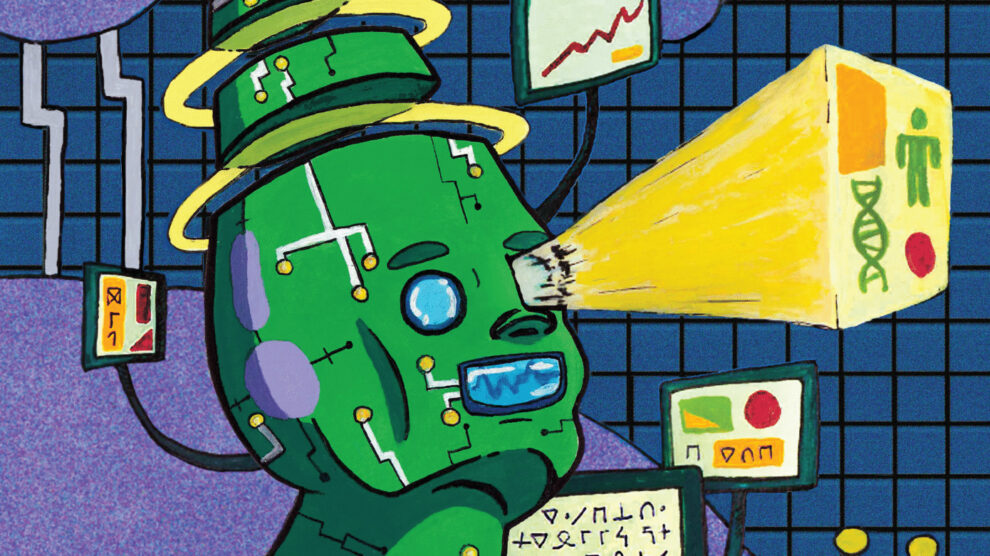Do No Evil: An Interview with Noah Hutton
By Helen Zhao
Volume 24, Number 2, Don’t Be Evil
Also check out our online-exclusive review of Noah Hutton’s In Silico, From Scientists to Salesmen.

Technology is often defined as “the things that make our lives easier”: dishwashers, cars, smartphones, wheels. But such a conception leaves unanalyzed its ramifying, often ambivalent effects on our world. Technologies, after all, are not just physical artifacts. Nor do they simply grease the joints of human action. As Science for the People has long argued, all scientific research is embedded in stratified landscapes of power.
Lapsis, a 2020 sci-fi feature written, directed, scored, and edited by Noah Hutton, artfully illustrates this lesson. Taking place in a counterfactual present, the film tells the story of gig workers pulling cable (“cabling”) across Allegheny State Park, organizing for better working conditions—in part, a collective fight to shut down the automated cabling carts owned by their employer, CBLR.
In June, Helen Zhao met with director, Noah Hutton, to discuss Lapsis and the various ways, storied by the film, that science can and already does do evil.
Note: This article contains spoilers. Readers might prefer to watch the film before reading. Lapsis is available to stream online.
• • •
HZ: Hey Noah, thanks again for sitting down with me to talk about your film, Lapsis. I really enjoyed it, both as a work of art and a reflective essay on the interactions between technology, labor, capital, and ideology.
I thought we might begin by discussing a general takeaway. In Lapsis, while computing and surveillance technologies are highly developed, essential scientific and engineering questions remain unanswered. I was wondering whether you built the world of Lapsis with this in mind, that under capitalism, technologies for profit tend to be prioritized over technologies that serve human needs.
NH: Yes, that was purposefully constructed. On the one hand, in the film, the market incentivizes the creation of technology and infrastructure that provide a new way to extract wealth from working people and place it in the hands of a few. This new infrastructure is as deregulated and privatized as possible. On the other hand, you have a health care system trending more and more towards individualized wellness strategies.
Jamie, the character in the film suffering from a chronic fatigue syndrome called Omnia, finds a tea that actually helps him. But because things like this tea aren’t standardized and distributed to more people through universal access to health care, they end up in very expensive boutiques where only a few people can access them.
HZ: Something I appreciate about the film is its focus on the use of surveillance technology in regulating labor. For example, in this world, cabling medallions are disturbingly able to detect when cablers are taking breaks. They sound an alarm if one of those breaks is unscheduled. What are your thoughts about surveillance vis-à-vis labor discipline?
NH: Well, what I was thinking about was this promise of A.I. that was never realized and may fail to be realized for some time, that A.I. would replace human labor, one-to-one. Because A.I. can’t replicate many human abilities, in Lapsis, I imagined it would be repurposed as the ultimate hall monitor. It would know what the human needs to do better than the human itself. So rather than replacing human workers, A.I. would now bark at humans.
I see this use of technology already happening in our world in the way that Amazon deploys A.I. to monitor its drivers. Internal training videos were leaked, showing A.I. warning drivers through facial recognition technology that they’re about to go to sleep behind the wheel.1
HZ: In this world, companies sell cabling as a gig by talking about how it’s “so good for you” and it’s a way of “challenging your status quo.” I thought this was one of the smartest elements of the film’s writing: the way these companies convincingly and realistically sold exploitation.
NH: You know, I put myself in the shoes of a cabling company, and I asked myself, how would they try to shape the aesthetic of cabling to appeal to people? They want people who are looking for weekend trips outside of cities. They want millennials to find cabling cool. But, more centrally, I was thinking about “threshold limits” in environmental science and pollution science. This is the idea that it’s okay for companies or industries to pollute up to a threshold limit of harm, and the role of science is to figure out to what extent it’s okay for companies to degrade the earth.
I wanted to play with the idea that companies with enough clout might shift the acceptable window of pollution. In Lapsis, because of companies like CBLR, the threshold limit has moved significantly. So now it’s okay for cables to be everywhere in Allegheny State Park; it’s okay to have these derelict structures out in the woods, to have all sorts of industrial waste, old batteries and stuff, from the traffic that’s passing through. There’s a hidden contradiction between the companies’ marketing, which depicts cabling as low-tech and low-impact, and the actual impact of cabling on the environment. By Trojan horse-ing the environmental impact in that aesthetic package, companies manage to significantly push the threshold limit of harm.
I think this is a common theme. Technology does evil under the wrappings of doing good. We say, “we’re going to tell you when you’re sleeping at the wheel!” And, we say, “By the way, you can’t have any bathroom breaks.”
It’s so important for scientists not to hide behind their alleged neutrality.
HZ: In the seventies, Science for the People had a campaign they called the Technical Assistance Program, which aimed to demystify technology for grassroots communities.2 The thought was that if you impart technical information and skills to communities, this would help communities to become more self-sufficient and empowered. So at some point, there was a hope—and perhaps there remains a hope—that through science and technical education, people could recoup power that companies, which create and own these opaque technologies, currently exert over us.
NH: I don’t think everyone has to learn technical skills. Of course, it’s important to have that education available to those who want to pursue that. But what really matters is that people who have the skills use the skills to make services that help working class people in equal measure.
There’s this new ride-share service in New York, the Drivers Cooperative. I assume that someone had the technical knowledge to develop the app. But more importantly, thousands and thousands of drivers can now sign up with this service. Just like the rest of us, most drivers don’t know how to program or code. They know how to get an app and sign up. I think that’s enough.
HZ: I’m going to pivot again to talk about automation. We’ve already touched on some of this in our conversation, but I just want to press you more about the film’s take.
There’s been a longstanding worry that with the advent of automation comes not only changes to working conditions and a rise in unemployment, but also changes to the kinds of labor actions that workers can take to effectively fight back against their employer.
In Lapsis, it appears that going on strike isn’t sufficient to shut down CBLR. But you noted earlier that you imagined automated cabling carts wouldn’t have the ability to replace human labor wholesale. One would think that a strike, then, would be enough to compel CBLR to negotiate with cablers over their working conditions. Why was it necessary for cablers to also shut down the automated carts?
NH: I felt that if cablers had just withheld their labor, CBLR would have simply deployed more automated carts, which would have tightened the company’s margins but wouldn’t have brought it to its knees. Obviously, the prospect of companies deploying new workers to a zone during a strike is always a concern of labor organizing. So I thought, in this world, to maximize their bargaining power, cablers would have had to shut down the automated carts as well. They would have had to prevent the carts from scabbing, in other words.
HZ: In the film, there’s a sense in which it’s technology that saves the day. Had the engineer behind the automated carts not coded a kill switch into the carts, there would have been no way for the workers to shut them down. I’m wondering if this feature of the plot is intended to speak to the possible role of another kind of labor action in addition to strikes, a way of using tech to kill tech to interrupt production. I’m thinking of Luddites, for instance, who didn’t just strike but smashed the means of production. They destroyed machines.
NH: Yeah, I wish there were more kill switches programmed into all sorts of technology, especially into technologies for massive corporations that promise to do no evil. That way, as soon as they inevitably started doing evil, you know, a decade later, there would be some sort of leverage to hold them accountable.
HZ: You’ve mentioned “doing evil.” As you know, the theme of this issue is “Don’t Be Evil.” In January 1970, Scientists and Engineers for Social and Political Action, an early name for Science for the People, circulated the following pledge at a meeting of the American Physical Society:
“I pledge that I won’t participate in more research on weapons production, and I further pledge to counsel my students and urge my colleagues to do the same.”
The action met with criticism.3 Some argued the pledge would pose no threat to scientific institutions of war-making. It reproduced the myth that an individual scientist can exercise control over what their research is used for and wrongly implied that individuals who fail to extricate themselves from institutions of weapons production are morally blameworthy. Meanwhile, others argued that the pledge could serve as a consciousness-raising device, a way of recruiting scientists to more effective forms of political action.
What are your thoughts about this pledge? Do you think that getting scientists and tech workers to commit to a pledge would be one way of making sure that they don’t do evil?
NH: I like the pledge very much. But I think that the force of the pledge quickly gets complicated when you’re doing basic scientific research. I’ve seen this especially while working on In Silico, my documentary about the Blue Brain Project. You can say, “I’m not going to participate in research for weapons manufacturing, in research that does direct harm.” But once the research is done and released into the world, it can quickly go into a pipeline that does do direct harm. That’s why it’s so important for scientists not to hide behind their alleged neutrality. They have to take political positions and build collective power toward those positions on these issues.
HZ: Right. It’s challenging to control the consequences of research, even when that research isn’t funded by DARPA, etc. But another big problem is that so much research depends on money from governmental and private funding bodies with the wrong aims. Scientists and engineers also need wages. And if their wages depend on winning grants year after year, doing the kind of research that funding bodies value, even when it goes against their individual values, then they don’t really have a choice.
NH: Yes. The pledge is just abstract enough to make it palatable. And so, while I think it is good of course, these days, we need to be much more specific.
HZ: What would you say a scientist who does no evil looks like?
NH: Well. I don’t think that there is any such thing as purity. I think everyone is going to be a little compromised by living in our world. And that’s fine. But I would look at someone like Max Liboiron, who I made the film Guts about. They’re a plastics researcher in Newfoundland. Their lab, the CLEAR Lab, does just as much research, if not more, on how to do science. Their number one rule in the lab is, if you’re heartbroken, sick, or tired, you go home. And they’ve published papers and gotten grants to do work on their methodologies as well as their basic research into plastics pollution off the coast of Canada.
I think this is a wonderful model, because the CLEAR Lab is doing science not just to challenge pollution caused by capitalism, but also to challenge the status quo of how scientists do science and relate to one another. Both kinds of research are needed, because there’s so much that’s broken within the system.
HZ: I’ll end with this quote from the call for pitches for this issue of Science for the People magazine: “Tech workers can either rationalize their complicity with the system or organize against it.” What do you think tech workers organizing against the system today looks like?
NH: I really love the Driver’s Cooperative. Here, so many things have ostensibly changed. The way workers relate to one another. The customer. The flow of capital. And upstream of that, the people who are programming this app have now used their technical and scientific knowledge for workers. I think the ideal is to go up and down, helping improve the lives of working people at every step. It’s time to do more than reinforce “threshold limits” of harm. Scientists need to start pushing back in the opposite direction now.
• • •

Noah Hutton is a writer and director of documentary and narrative films. He was nominated for the 2021 Independent Spirit Award for Best First Screenplay for Lapsis. His other work includes documentaries like Guts, which explores a feminist, anti-colonial marine science lab based in Newfoundland, and Crude Independence and Deep Time, which depict the effects of an oil boom on small town and indigenous communities in North Dakota.
If you liked this article, please consider subscribing or purchasing print or digital versions of our magazine. You can also support us by becoming a Patreon donor.
Notes
- Jay Stanley, “Amazon Drivers Placed Under Robot Surveillance Microscope,” ACLU, March 23, 2021, https://www.aclu.org/news/privacy-technology/amazon-drivers-placed-under-robot-surveillance-microscope/.
- Thomas Conner and Sigrid Schmalzer, “Technology,” in Documents from America’s Movement of Radical Scientists, (Amherst: University of Massachusetts Press, 2018), 155–75.
- Britta Fischer, “Two Views of the Pledge,” Science for the People 2, no. 2 (August 1970): 2, accessed July 12, 2021, https://archive.scienceforthepeople.org/vol-2/v2n2/two-views/.





